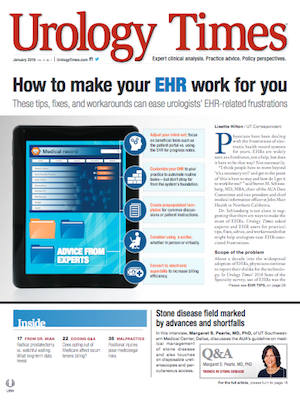Publication
Article
Urology Times Journal
What 2019 MIPS changes mean for your practice
Author(s):
A limited number of outcome measures available to urologists.
On Nov. 23, 2018, the Centers for Medicare & Medicaid Services (CMS) published its final rule revising payment policies under the Medicare Physician Fee Schedule. Most of the proposed changes to the Quality Payment Program outlined in the proposed rule were finalized (see, “How proposed rule will affect Quality Payment Program,” September 2018). In this article, I will summarize those changes to the Quality Payment Program that may impact your urology practice.
MIPS eligibility. The low-volume thresholds for Merit-based Incentive Payment System (MIPS) eligibility were finalized as proposed. Individuals or groups that do not exceed $90,000 in Medicare charges, 200 unique beneficiaries, or 200 professional services will be automatically excluded from MIPS. Clinicians who exceed all three of these thresholds will automatically participate in MIPS, and those who exceed one or two criteria can opt into the program.
Urology practices that employ physician assistants or nurse practitioners-who may not exceed these low-volume thresholds as individuals-may wish to participate as a group, especially in the early years of a program when positive payment adjustments are more achievable.
MIPS composite score. The MIPS composite score required to avoid a negative adjustment was finalized at 30 points, and the threshold for participating in the “exceptional performance” pool of $500 was changed from 70 points to 75 points for the 2019 performance year. By statute, the maximum payment adjustment earned by performance during 2019 (applied in 2021) is +/–7%.
The final rule did not include any estimates of impact by specialty using these new thresholds, but in aggregate CMS projects that 798,000 eligible clinicians will participate in MIPS in 2019 (up from 604,000 in 2018), and $390 million in negative adjustments will be redistributed to MIPS clinicians who have a positive performance in 2019 (up from an estimated $118 million in 2018). The actual impact by MIPS composite score will not be known until a scaling factor is applied for the payment year, as required by law. Urologists should understand that the bar for performance will continue to rise and strive to achieve maximum performance to participate.
Also by Dr. Dowling - Disaster preparation: Make sure your practice is ready
Quality category. A number of changes to the Quality category were finalized in the rule. As proposed, the 2019 weight for Quality will be 45%, and groups of 15 or fewer physicians can submit some quality measures via Part B claims whether they submit as individuals or as a group. Those same “small groups” can qualify for six bonus points added to the numerator of the Quality performance category if they submit data on at least one quality measure, a more generous bonus than originally proposed.
Also, eligible clinicians can submit quality measures via multiple different collection types-a change from previous years. The urology specialty measure set remains largely unchanged from 2018; proposed changes to add a BPH outcome measure and remove an incontinence measure were not finalized.
Urologists continue to have a limited number of outcome measures available, and MIPS requires that at least one outcome measure be reported. The selection of quality measures continues to be largely determined by which EHR and/or registry is used for MIPS reporting. Practices should know which measures they can choose from and have some mechanism in place to measure performance in real time and improve.
Next:Cost, Improvement Activities, Promoting Interoperability categoriesCost category. Proposed changes to the Cost category were finalized, and the category will have 15% weight in the 2019 performance year. New inpatient and procedure episode measures were finalized, and none impact urology in 2019. As reported earlier, urologists will probably be impacted in 2020 with an episode measure for kidney stones. It is not too early to begin thinking about controlling costs that are under your control, as performance in this area will eventually have major impact on the MIPS score.
Read: CMS data breaks down industry payments to urologists
Improvement Activities category. This category (15% weight, 90-day reporting period) contains no significant proposed changes to the inventory of activities for the specialty of urology, and the activity weights (high, medium) and scores remain the same. However, the bonus for using certified EHR technology associated with some activities has been eliminated. This category continues to be easy for urologists.
Promoting Interoperability category. The most significant changes to MIPS were finalized in the Promoting Interoperability category. All scoring will be based on performance, and the measures have been consolidated into four objectives. Performance in this category will be optimized by maximizing e-prescribing, implementing electronic prescribing of controlled substances, making sure all patients are offered registration on a patient portal, and understanding the sending and receiving of care summaries. Practices should review these changes with their EHR vendor and monitor clinician performance in this category carefully. Finally, urologists will need to use 2015 EHR certified technology in order to achieve points in the Promoting Interoperability category-check with your vendor to be sure you are, or soon will be, upgraded.
Bottom line: The Quality Payment Program and MIPS continue to evolve, and urologists continue to have an opportunity to achieve positive payment adjustments. Future years should bring more urology-specific measures.

Newsletter
Stay current with the latest urology news and practice-changing insights — sign up now for the essential updates every urologist needs.





















